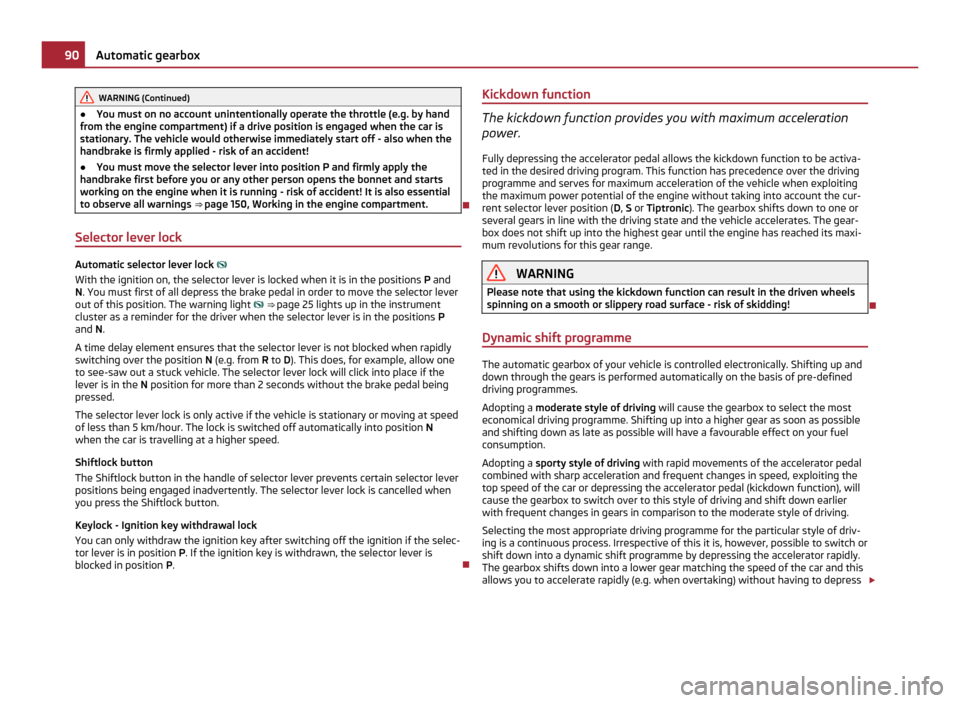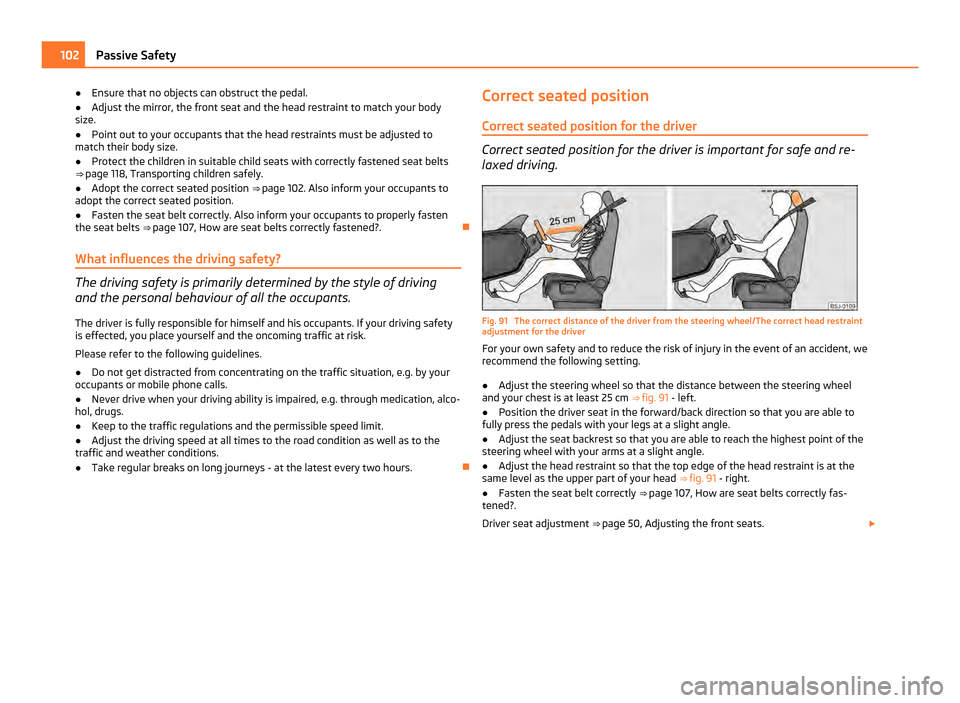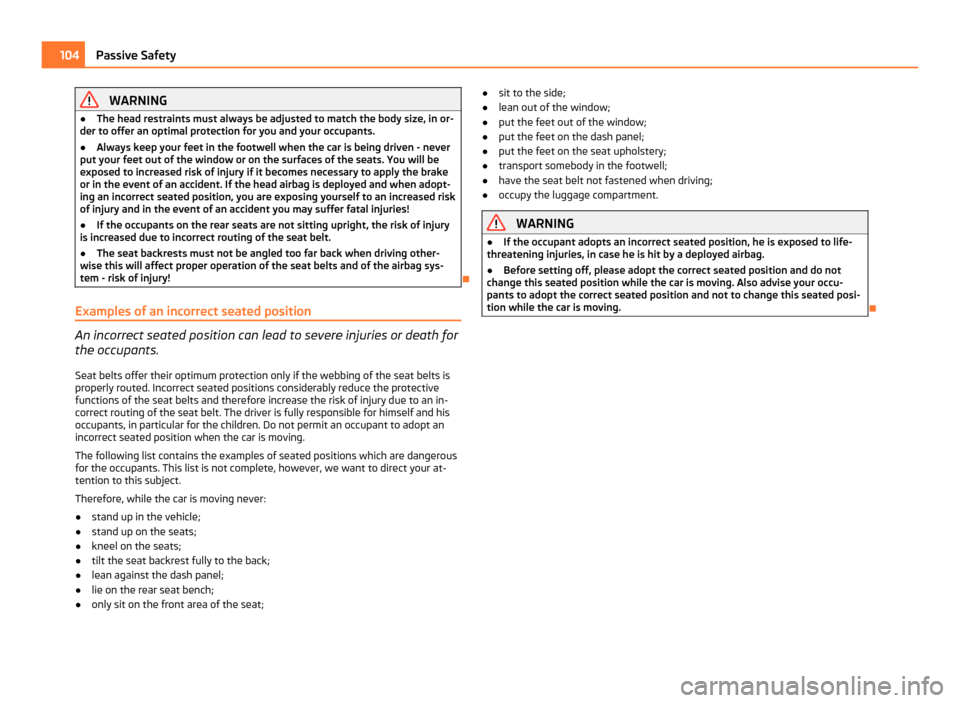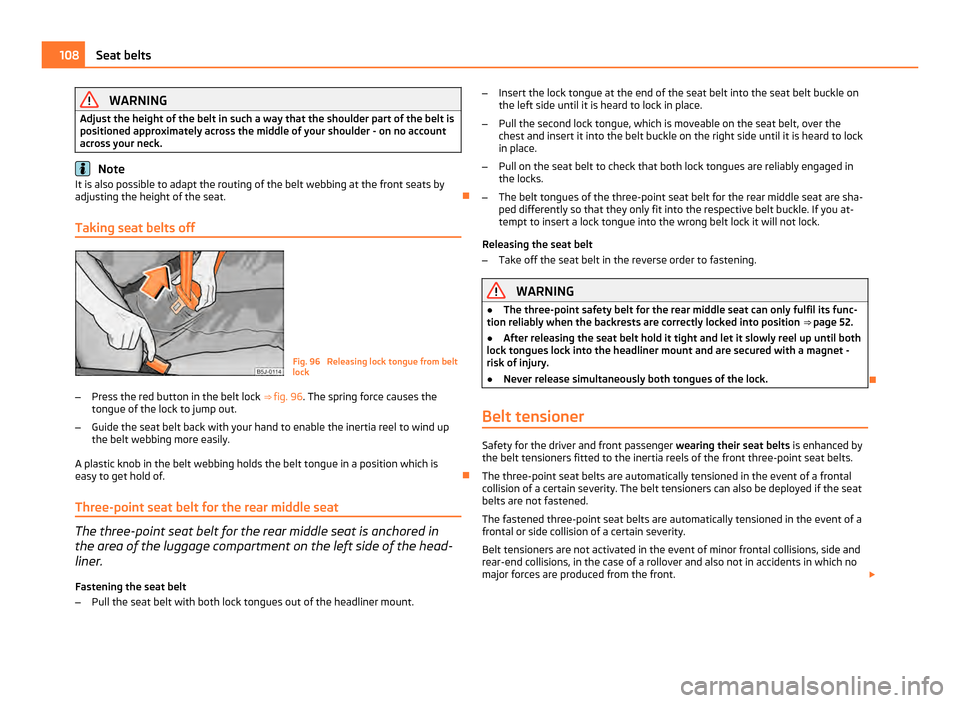2011 SKODA ROOMSTER ESP
[x] Cancel search: ESPPage 92 of 212

WARNING (Continued)
● You must on no account unintentionally operate the throttle (e.g. by hand
from the engine compartment) if a drive position is engaged when the car is
stationary. The vehicle would otherwise immediately start off - also when the
handbrake is firmly applied - risk of an accident!
● You must move the selector lever into position P and firmly apply the
handbrake first before you or any other person opens the bonnet and starts
working on the engine when it is running - risk of accident! It is also essential
to observe all warnings ⇒ page 150
, Working in the engine compartment.
Selector lever lock Automatic selector lever lock
With the ignition on, the selector lever is locked when it is in the positions P and
N. You must first of all depress the brake pedal in order to move the selector lever
out of this position. The warning light ⇒
page 25 lights up in the instrument
cluster as a reminder for the driver when the selector lever is in the positions P
and N.
A time delay element ensures that the selector lever is not blocked when rapidly
switching over the position N (e.g. from R to D). This does, for example, allow one
to see-saw out a stuck vehicle. The selector lever lock will click into place if the
lever is in the N position for more than 2 seconds without the brake pedal being
pressed.
The selector lever lock is only active if the vehicle is stationary or moving at speed
of less than 5 km/hour. The lock is switched off automatically into position N
when the car is travelling at a higher speed.
Shiftlock button
The Shiftlock button in the handle of selector lever prevents certain selector lever
positions being engaged inadvertently. The selector lever lock is cancelled when
you press the Shiftlock button.
Keylock - Ignition key withdrawal lock
You can only withdraw the ignition key after switching off the ignition if the selec-
tor lever is in position P. If the ignition key is withdrawn, the selector lever is
blocked in position P . Kickdown function The kickdown function provides you with maximum acceleration
power.
Fully depressing the accelerator pedal allows the kickdown function to be activa-
ted in the desired driving program. This function has precedence over the driving
programme and serves for maximum acceleration of the vehicle when exploiting
the maximum power potential of the engine without taking into account the cur-
rent selector lever position ( D, S or Tiptronic ). The gearbox shifts down to one or
several gears in line with the driving state and the vehicle accelerates. The gear-
box does not shift up into the highest gear until the engine has reached its maxi-
mum revolutions for this gear range. WARNING
Please note that using the kickdown function can result in the driven wheels
spinning on a smooth or slippery road surface - risk of skidding!
Dynamic shift programme The automatic gearbox of your vehicle is controlled electronically. Shifting up and
down through the gears is performed automatically on the basis of pre-defined
driving programmes.
Adopting a moderate style of driving
will cause the gearbox to select the most
economical driving programme. Shifting up into a higher gear as soon as possible
and shifting down as late as possible will have a favourable effect on your fuel
consumption.
Adopting a sporty style of driving with rapid movements of the accelerator pedal
combined with sharp acceleration and frequent changes in speed, exploiting the
top speed of the car or depressing the accelerator pedal (kickdown function), will
cause the gearbox to switch over to this style of driving and shift down earlier
with frequent changes in gears in comparison to the moderate style of driving.
Selecting the most appropriate driving programme for the particular style of driv-
ing is a continuous process. Irrespective of this it is, however, possible to switch or
shift down into a dynamic shift programme by depressing the accelerator rapidly.
The gearbox shifts down into a lower gear matching the speed of the car and this
allows you to accelerate rapidly (e.g. when overtaking) without having to depress £90
Automatic gearbox
Page 93 of 212

the accelerator pedal fully into the kickdown range. The original programme will
be reactivated to match your particular style of driving once the gearbox has shif-
ted up again.
When driving in hilly regions, the gears are selected to match uphill and downhill
sections. This avoids the gearbox frequently shifting up and down when negotiat-
ing an uphill stretch. When driving downhill, it is possible to shift down into the
Tiptronic position, in order to exploit the engine brake torque.
Tiptronic The Tiptronic allows the driver to also shift gears manually.
Fig. 85 Selector lever: manual shifting/large information display: Manual shifting of gears
The selector lever position you have engaged is indicated in the information dis-
play of the instrument cluster together with the engaged gear
⇒ fig. 85 on the
right.
Switching over to manual shifting
– Push the selector lever to the right out of position D. After switching over, the
current engaged gear is indicated in the display.
Shifting up gears
– One-touch forward of the selector lever (in the Tiptronic position) ⇒ fig. 85 + .
Shifting down gears
– One-touch back of the selector lever (in the Tiptronic position) - .
It is possible to switch over to manual both when the car is stationary and also
when driving. When you accelerate, the gearbox shifts up automatically into the higher gear just
before the maximum permissible engine speed is reached.
If you select a lower gear, the automatic gearbox does not shift down until there
is no risk of the engine overrevving.
When you operate the kickdown feature, the gearbox shifts into a lower gear in
line with the vehicle speed and engine speed.
Emergency programme An emergency programme exists in the event of a fault in the sys-
tem.
The gearbox operates in a corresponding emergency programme if there are func-
tional faults in the gearbox electronics. This is indicated by all of the segments in
the display lighting up or going out.
A functional fault can have the following effect:
● The gearbox only shifts into certain gears.
● The reverse gear R cannot be used.
● The manual shift programme (Tiptronic) is switched off in the emergency
mode.
If the gearbox has switched over to emergency mode, drive to the nearest spe-
cialist garage in order to have the fault rectified.
Selector lever-emergency unlocking Fig. 86 Selector lever-emergency un-
locking
£ 91
Automatic gearbox Using the system Safety Driving Tips General Maintenance Breakdown assis-
tance Praktik Technical data
Page 95 of 212

Communication
Multifunction steering wheel
Operate radio and radio navigation system on the multifunction steering wheel Fig. 87 Multifunction steering wheel:
control buttons
The buttons for setting the basic functions of the factory-fitted radio and radio
navigation system are located on the multifunction steering wheel
⇒ fig. 87.
You can of course operate the radio and radio navigation system at the appliance.
You will find a description in the relevant Owner's manual.
If the side lights are switched on, the buttons on the multifunction steering wheel
are also illuminated except the symbols and .
By pressing or turning the buttons, you can carry out the following functions. Button Action Radio, traffic information CD/MP3/Navigation
1
press briefly
a) Switch off/on tone
1 press for a long
period of time a) Switch the unit on/off
1
turn upwards Increase volume
1
turn downwards Decrease volume
2
press briefly Changing to the next stored radio station
Changing to the next stored traffic information Interrupting the traffic report Changing to the next title
2 press button for
a long time Interruption of the traffic report Fast forward
3
press briefly Changing to the previously stored radio station
Changing to the previously stored traffic information Interrupting the traffic report Changing to the previous title
3
press button for
a long time Interruption of the traffic report Fast rewind
a)
On vehicles which are equipped with the universal telephone preinstallation GSM II, pressing the button 1 only allows to operate the telephone.
The buttons apply for the respective operating mode of the current radio or radio
navigation system. Note
The loudspeakers in the vehicle are matched to a power output of the radio and
radio navigation system of 4x 20 W. 93
Communication Using the system Safety Driving Tips General Maintenance Breakdown assis-
tance Praktik Technical data
Page 103 of 212

Safety
Passive Safety
Basic information
Driving the safe way Passive safety measures reduce the risk of injury in accident situa-
tions.
In this section you will find important information, tips and notes on the subject of
passive safety in your vehicle. We have combined everything here which you
should be familiar with, for example, regarding seat belts, airbags, child seats and
safety of children. Therefore, please follow especially the notes and warnings in
this section in your own interest and in the interest of your passengers. WARNING
● This chapter contains important information on how to use the vehicle for
the driver and his occupants. You will find further information on safety, which
concerns you and those travelling with you, in the following chapters of this
Owner's Manual.
● The complete on-board literature should always be in the vehicle. This ap-
plies in particular, if you rent out or sell the vehicle.
Safety equipment The safety equipment is part of the occupant protection and it can
reduce the risk of injuries in accident situations.
“Do not put at risk
” your safety and the safety of those travelling with you . In the
event of an accident, the safety equipment can reduce the risk of injuries.
The following list contains part of the safety equipment in your vehicle:
● three-point seat belts for all the seats;
● belt force limiters for front seats;
● belt tensioners for front seats; ●
seat belt height adjusters for front seats;
● front airbag for the driver and front passenger;
● side airbags;
● head airbags;
● anchoring points for child seat using the “ISOFIX” system;
● anchoring points for child seat using the “Top Tether” system;
● head restraints adjustable for height;
● adjustable steering column.
The specified safety equipment works together, in order to optimally protect you
and those travelling with you in accident situations. The safety equipment does
not protect you or the people travelling with you, if you or your occupants adopt
an incorrect seated position or the equipment is not correctly adjusted or used.
For this reason you will be provided with information on why these equipment
components are very important, how it protects you and the occupants, what
should be observed when using the equipment and how you and the people trav-
elling with you can make full use of the existing safety equipment. This Owner's
Manual contains important warning notes, which you and those travelling with
you should pay attention to in order to reduce a risk of injury.
Safety concerns everybody!
Before setting off The driver is always fully responsible for his occupants and for the
operating safety of the vehicle.
For your own safety and the safety of the people travelling with you, please pay
attention to the following points before setting off.
● Ensure that the lighting and the turn signal systems are functioning properly.
● Inspect the tyre inflation pressure.
● Ensure that all the windows offer a good visibility to the outside.
● Safely attach the items of luggage ⇒ page 55, Loading the luggage compart-
ment
. £ 101
Passive Safety Using the system Safety Driving Tips General Maintenance Breakdown assis-
tance Praktik Technical data
Page 104 of 212

●
Ensure that no objects can obstruct the pedal.
● Adjust the mirror, the front seat and the head restraint to match your body
size.
● Point out to your occupants that the head restraints must be adjusted to
match their body size.
● Protect the children in suitable child seats with correctly fastened seat belts
⇒ page 118, Transporting children safely .
● Adopt the correct seated position ⇒
page 102. Also inform your occupants to
adopt the correct seated position.
● Fasten the seat belt correctly. Also inform your occupants to properly fasten
the seat belts ⇒
page 107, How are seat belts correctly fastened?.
What influences the driving safety? The driving safety is primarily determined by the style of driving
and the personal behaviour of all the occupants.
The driver is fully responsible for himself and his occupants. If your driving safety
is effected, you place yourself and the oncoming traffic at risk.
Please refer to the following guidelines.
● Do not get distracted from concentrating on the traffic situation, e.g. by your
occupants or mobile phone calls.
● Never drive when your driving ability is impaired, e.g. through medication, alco-
hol, drugs.
● Keep to the traffic regulations and the permissible speed limit.
● Adjust the driving speed at all times to the road condition as well as to the
traffic and weather conditions.
● Take regular breaks on long journeys - at the latest every two hours. Correct seated position
Correct seated position for the driver Correct seated position for the driver is important for safe and re-
laxed driving.
Fig. 91 The correct distance of the driver from the steering wheel/The correct head restraint
adjustment for the driver
For your own safety and to reduce the risk of injury in the event of an accident, we
recommend the following setting.
● Adjust the steering wheel so that the distance between the steering wheel
and your chest is at least 25 cm ⇒ fig. 91 - left.
● Position the driver seat in the forward/back direction so that you are able to
fully press the pedals with your legs at a slight angle.
● Adjust the seat backrest so that you are able to reach the highest point of the
steering wheel with your arms at a slight angle.
● Adjust the head restraint so that the top edge of the head restraint is at the
same level as the upper part of your head ⇒
fig. 91 - right.
● Fasten the seat belt correctly ⇒
page 107, How are seat belts correctly fas-
tened?.
Driver seat adjustment ⇒ page 50, Adjusting the front seats. £102
Passive Safety
Page 106 of 212

WARNING
● The head restraints must always be adjusted to match the body size, in or-
der to offer an optimal protection for you and your occupants.
● Always keep your feet in the footwell when the car is being driven - never
put your feet out of the window or on the surfaces of the seats. You will be
exposed to increased risk of injury if it becomes necessary to apply the brake
or in the event of an accident. If the head airbag is deployed and when adopt-
ing an incorrect seated position, you are exposing yourself to an increased risk
of injury and in the event of an accident you may suffer fatal injuries!
● If the occupants on the rear seats are not sitting upright, the risk of injury
is increased due to incorrect routing of the seat belt.
● The seat backrests must not be angled too far back when driving other-
wise this will affect proper operation of the seat belts and of the airbag sys-
tem - risk of injury!
Examples of an incorrect seated position An incorrect seated position can lead to severe injuries or death for
the occupants.
Seat belts offer their optimum protection only if the webbing of the seat belts is
properly routed. Incorrect seated positions considerably reduce the protective
functions of the seat belts and therefore increase the risk of injury due to an in-
correct routing of the seat belt. The driver is fully responsible for himself and his
occupants, in particular for the children. Do not permit an occupant to adopt an
incorrect seated position when the car is moving.
The following list contains the examples of seated positions which are dangerous
for the occupants. This list is not complete, however, we want to direct your at-
tention to this subject.
Therefore, while the car is moving never:
● stand up in the vehicle;
● stand up on the seats;
● kneel on the seats;
● tilt the seat backrest fully to the back;
● lean against the dash panel;
● lie on the rear seat bench;
● only sit on the front area of the seat; ●
sit to the side;
● lean out of the window;
● put the feet out of the window;
● put the feet on the dash panel;
● put the feet on the seat upholstery;
● transport somebody in the footwell;
● have the seat belt not fastened when driving;
● occupy the luggage compartment. WARNING
● If the occupant adopts an incorrect seated position, he is exposed to life-
threatening injuries, in case he is hit by a deployed airbag.
● Before setting off, please adopt the correct seated position and do not
change this seated position while the car is moving. Also advise your occu-
pants to adopt the correct seated position and not to change this seated posi-
tion while the car is moving. 104
Passive Safety
Page 110 of 212

WARNING
Adjust the height of the belt in such a way that the shoulder part of the belt is
positioned approximately across the middle of your shoulder - on no account
across your neck. Note
It is also possible to adapt the routing of the belt webbing at the front seats by
adjusting the height of the seat.
Taking seat belts off Fig. 96 Releasing lock tongue from belt
lock
– Press the red button in the belt lock ⇒ fig. 96 . The spring force causes the
tongue of the lock to jump out.
– Guide the seat belt back with your hand to enable the inertia reel to wind up
the belt webbing more easily.
A plastic knob in the belt webbing holds the belt tongue in a position which is
easy to get hold of.
Three-point seat belt for the rear middle seat The three-point seat belt for the rear middle seat is anchored in
the area of the luggage compartment on the left side of the head-
liner.
Fastening the seat belt
– Pull the seat belt with both lock tongues out of the headliner mount. –
Insert the lock tongue at the end of the seat belt into the seat belt buckle on
the left side until it is heard to lock in place.
– Pull the second lock tongue, which is moveable on the seat belt, over the
chest and insert it into the belt buckle on the right side until it is heard to lock
in place.
– Pull on the seat belt to check that both lock tongues are reliably engaged in
the locks.
– The belt tongues of the three-point seat belt for the rear middle seat are sha-
ped differently so that they only fit into the respective belt buckle. If you at-
tempt to insert a lock tongue into the wrong belt lock it will not lock.
Releasing the seat belt
– Take off the seat belt in the reverse order to fastening. WARNING
● The three-point safety belt for the rear middle seat can only fulfil its func-
tion reliably when the backrests are correctly locked into position ⇒
page 52.
● After releasing the seat belt hold it tight and let it slowly reel up until both
lock tongues lock into the headliner mount and are secured with a magnet -
risk of injury.
● Never release simultaneously both tongues of the lock.
Belt tensioner Safety for the driver and front passenger
wearing their seat belts is enhanced by
the belt tensioners fitted to the inertia reels of the front three-point seat belts.
The three-point seat belts are automatically tensioned in the event of a frontal
collision of a certain severity. The belt tensioners can also be deployed if the seat
belts are not fastened.
The fastened three-point seat belts are automatically tensioned in the event of a
frontal or side collision of a certain severity.
Belt tensioners are not activated in the event of minor frontal collisions, side and
rear-end collisions, in the case of a rollover and also not in accidents in which no
major forces are produced from the front. £108
Seat belts
Page 111 of 212

WARNING
● Any work on the belt tightener system, including removal and installation
of system components because of other repair work, must only be carried out
by a specialist garage.
● The protective function of the system is only adequate for a single acci-
dent. If the belt tensioners have been deployed, it is then necessary to replace
the entire system.
● The seller must pass on this Owner's manual to the buyer upon purchase
of the vehicle. Note
● Smoke is generated when the belt tensioners are deployed. This is not an indi-
cation of a fire in the vehicle.
● It is essential to pay attention to relevant safety regulations if the vehicle or
individual parts of the system are scrapped. Specialist garages are familiar with
these regulations and will be able to provide you with detailed information in this
respect.
● When disposing of vehicle or parts of the system, it is important to comply
with the national legal requirements. 109
Seat belts Using the system Safety Driving Tips General Maintenance Breakdown assis-
tance Praktik Technical data